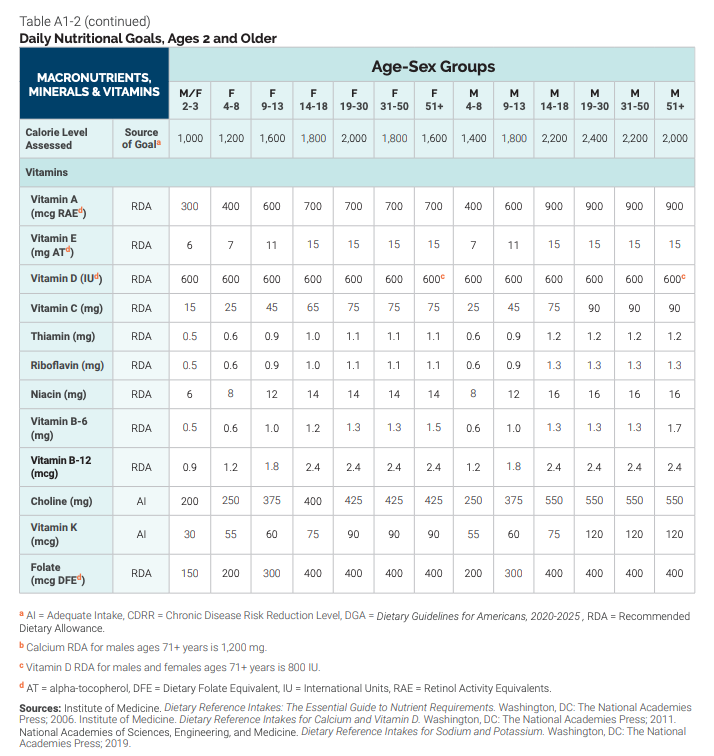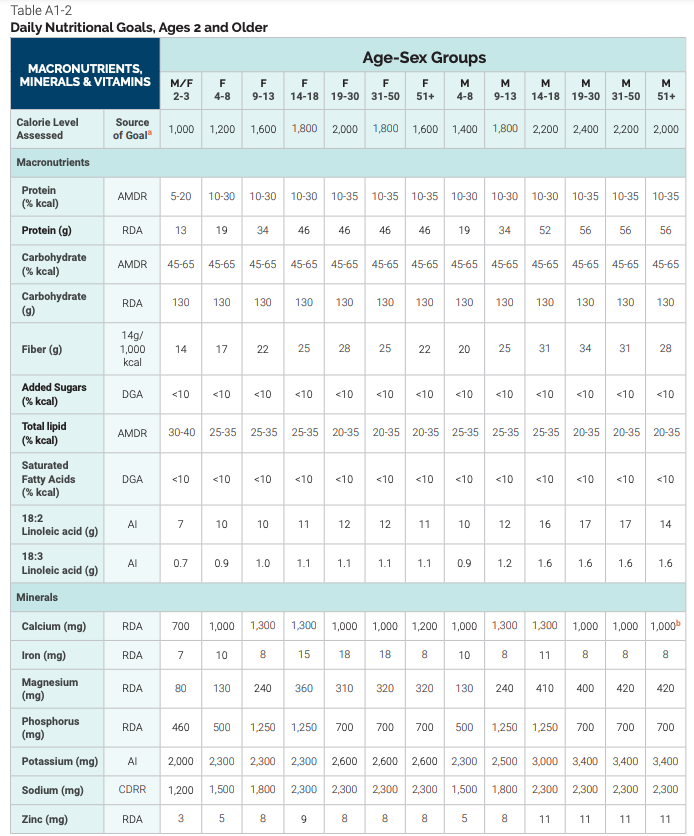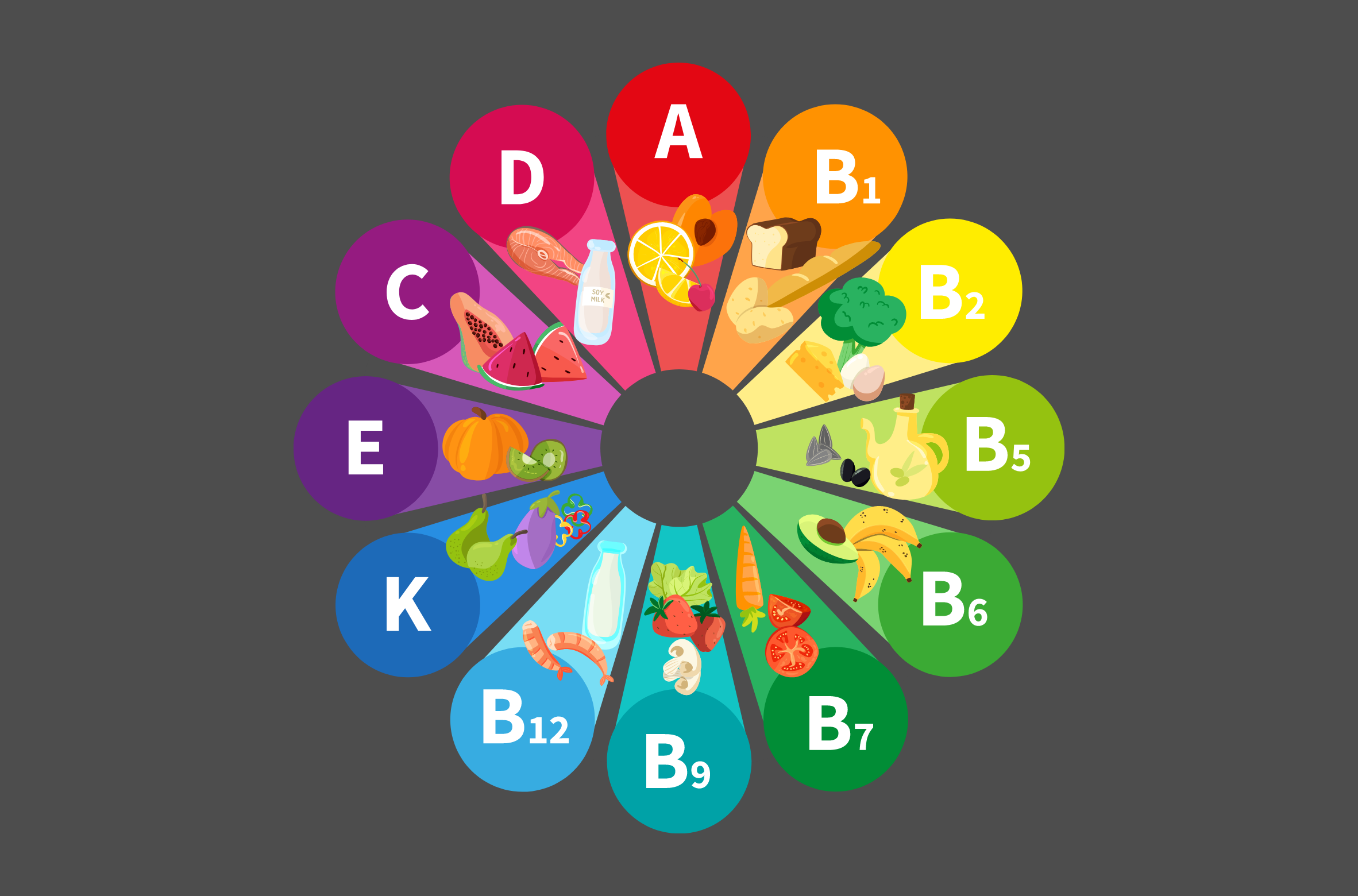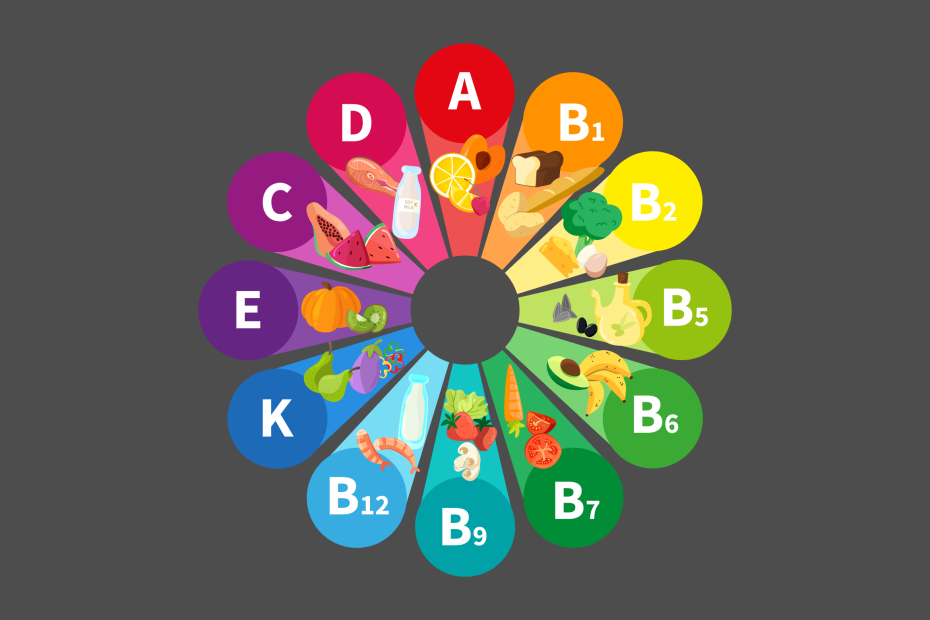Vitamins and Minerals 101
Vitamins are substances that are needed for a range of bodily functions, but that our bodies do not make. (One exception is vitamin D, which our skin makes from exposure to sunlight). This means we have to get them from food or supplements. Thirteen vitamins are considered essential for human health: A, C, D, E, K, and the B vitamins (thiamine, riboflavin, niacin, pantothenic acid, biotin, B6, B12, and folate).
Although vitamins are found in many different foods, here are some well-known examples:
- Vitamin A: carrots, tomatoes, milk.
- Important for vision, bone growth, reproduction, cell function, immune system.
- Vitamin C: citrus fruits, strawberries, cabbage
- Important for skin, bones, wound healing, iron absorption.
- Vitamin D: fatty fish like sardines and salmon. Our skin makes it from sunlight.
- Important for nerves, muscles, immune system, calcium absorption.
- Vitamin E: peanuts and sunflower seeds
- Important for immune system health and metabolic health.
- Vitamin K: green leafy vegetables such as kale, spinach, and collard greens
- Important for healthy bones and tissues.
- The eight B vitamins: many animal- and plant-based foods
- Important for a wide variety of functions, including making red blood cells.
Vitamins are generally categorized as either fat soluble or water soluble. One reason this matters is that the fat-soluble vitamins (A, D, E, K) are stored in our fat, which means they can build up and cause toxicity. Luckily, this is not common, but it means that people should be careful about taking vitamin supplements. (More is not always better.)
Water-soluble vitamins need to dissolve in water to work, but since the body is 60% water, this is not a problem. Excess amounts of these vitamins simply pass out of the body in urine.
Fun Fact: The colors of fruits and vegetables are the result of phytonutrients, which are natural compounds that help plants fight diseases, insects, and other environmental threats. Phytonutrients are not the same as vitamins, but foods that contain phytonutrients generally also contain vitamins. Antioxidants are one type of phytonutrient. They help cells fight damage. Vitamins A, C, and E are considered antioxidants.
Minerals are elements that are naturally found in the ground and in water, that our bodies need in small amounts. We also get these from foods we consume. Examples include calcium, sodium, potassium, iodine, and zinc.
Fun Fact:
Table salt is actually a combination of the minerals sodium and chloride. These are also electrolytes (see A Closer Look, below). Sodium is important for nerve and muscle function, but too much in your blood can cause high blood pressure—a risk factor for strokes, heart disease, and heart failure, among other health problems.
Pro Tip:
Most people get more than enough salt in their diet. The USDA recommends getting no more than a teaspoon per day (around 2,300 mg). But most Americans get around 3,400 mg! Processed/packaged food is a big source of salt. Check package labels to make sure you’re not getting way too much.
Food is one of the best ways to get vitamins and minerals, because the body absorbs them very effectively from food—plus there may be additional healthful nutrients, such as fiber, that are also present.
A Closer Look: Electrolytes
Electrolytes are substances that, when dissolved in water, have a positive or negative charge. Don’t let the definition intimidate you—you’ve already heard of electrolytes such as sodium, calcium, and magnesium. (Note that these are also minerals.)Electrolytes are important for many functions in the body. Sodium is important for keeping the right fluid balance in your body. Calcium, which is important for strong bones and teeth, also helps control your muscles. And magnesium helps your body turn food into energy. Because electrolytes are so essential to the body, doctors check electrolyte levels with several different tests, called “panels.” You may remember seeing the results from a basic or comprehensive metabolic panel, or an electrolyte panel. We lose electrolytes when we lose fluids: sweat, urine, diarrhea, vomiting. That’s why, when we get sick with things like stomach bugs, we are told to drink Gatorade or other fluids to prevent dehydration and replace those all-important lost electrolytes.
Sometimes, doctors will prescribe supplements for people who don’t get enough of a particular vitamin or mineral. (Supplements get their name from the fact that they supplement the diet.) For example, people who live in less-sunny places may be prescribed vitamin D supplements. Older people may be prescribed calcium, due to the bone loss that naturally occurs with aging (calcium is an important component of bones). Pregnant women may be prescribed folic acid (folate).
Pro Tip: You may have heard the expression, “Eat the rainbow.” This is a shorthand way to remember to eat a variety of colorful fruits and vegetables, in order to get a wide range of nutrients, including vitamins and minerals. It’s a lot easier to eat a variety of fruits and vegetables every day than to memorize tables of vitamins and minerals! (That said, we have included tables for people who like them, below.)
The USDA’s Dietary Guidelines for Americans 2020-2025 has tables with general vitamin and mineral recommendations:


And here is a table from Harvard Medical School that shows the many critical functions of vitamins, as well as foods that contain them:
| VITAMIN | BENEFITS | GOOD FOOD SOURCES |
| RETINOIDS AND CAROTENE (vitamin A; includes retinol, retinal, retinyl esters, and retinoic acid and are also referred to as “preformed” vitamin A. Beta carotene can easily be converted to vitamin A as needed.) | Essential for vision. Lycopene may lower prostate cancer risk. Keeps tissues and skin healthy. Plays an important role in bone growth and in the immune system. Diets rich in the carotenoids alpha carotene and lycopene seem to lower lung cancer risk. Carotenoids act as antioxidants. Foods rich in the carotenoids lutein and zeaxanthin may protect against cataracts | Sources of retinoids: beef liver, eggs, shrimp, fish, fortified milk, butter, cheddar cheese, Swiss cheese
Sources of beta carotene: sweet potatoes, carrots, pumpkins, squash, spinach, mangoes, turnip greens |
| THIAMIN (vitamin B1) | Helps convert food into energy. Needed for healthy skin, hair, muscles, and brain and is critical for nerve function. | Pork chops, brown rice, ham, soymilk, watermelons, acorn squash |
| RIBOFLAVIN (vitamin B2) | Helps convert food into energy. Needed for healthy skin, hair, blood, and brain | Milk, eggs, yogurt, cheese, meats, green leafy vegetables, whole and enriched grains and cereals. |
| NIACIN (vitamin B3, nicotinic acid) | Helps convert food into energy. Essential for healthy skin, blood cells, brain, and nervous system | Meat, poultry, fish, fortified and whole grains, mushrooms, potatoes, peanut butter |
| PANTOTHENIC ACID (vitamin B5) | Helps convert food into energy. Helps make lipids (fats), neurotransmitters, steroid hormones, and hemoglobin | Wide variety of nutritious foods, including chicken, egg yolk, whole grains, broccoli, mushrooms, avocados, tomato products |
| PYRIDOXINE (vitamin B6, pyridoxal, pyridoxine, pyridoxamine) | Aids in lowering homocysteine levels and may reduce the risk of heart disease. Helps convert tryptophan to niacin and serotonin, a neurotransmitter that plays key roles in sleep, appetite, and moods. Helps make red blood cells Influences cognitive abilities and immune function | Meat, fish, poultry, legumes, tofu and other soy products, potatoes, non-citrus fruits such as bananas and watermelons |
| COBALAMIN (vitamin B12) | Aids in lowering homocysteine levels and may lower the risk of heart disease. Assists in making new cells and breaking down some fatty acids and amino acids. Protects nerve cells and encourages their normal growth Helps make red blood cells and DNA | Meat, poultry, fish, milk, cheese, eggs, fortified cereals, fortified soymilk |
| BIOTIN | Helps convert food into energy and synthesize glucose. Helps make and break down some fatty acids. Needed for healthy bones and hair | Many foods, including whole grains, organ meats, egg yolks, soybeans, and fish |
| ASCORBIC ACID (vitamin C) | Foods rich in vitamin C may lower the risk for some cancers, including those of the mouth, esophagus, stomach, and breast. Long-term use of supplemental vitamin C may protect against cataracts. Helps make collagen, a connective tissue that knits together wounds and supports blood vessel walls. Helps make the neurotransmitters serotonin and norepinephrine Acts as an antioxidant, neutralizing unstable molecules that can damage cells. Bolsters the immune system | Fruits and fruit juices (especially citrus), potatoes, broccoli, bell peppers, spinach, strawberries, tomatoes, Brussels sprouts |
| CHOLINE | Helps make and release the neurotransmitter acetylcholine, which aids in many nerve and brain activities. Plays a role in metabolizing and transporting fats | Many foods, especially milk, eggs, liver, salmon, and peanuts |
| CALCIFEROL (vitamin D) | Helps maintain normal blood levels of calcium and phosphorus, which strengthen bones. Helps form teeth and bones. Supplements can reduce the number of non-spinal fractures | Fortified milk or margarine, fortified cereals, fatty fish |
| ALPHA-TOCOPHEROL (vitamin E) | Acts as an antioxidant, neutralizing unstable molecules that can damage cells. Protects vitamin A and certain lipids from damage. Diets rich in vitamin E may help prevent Alzheimer’s disease. | Wide variety of foods, including vegetable oils, salad dressings and margarines made with vegetable oils, wheat germ, leafy green vegetables, whole grains, nuts |
| FOLIC ACID (vitamin B9, folate, folacin) | Vital for new cell creation. Helps prevent brain and spine birth defects when taken early in pregnancy; should be taken regularly by all women of child-bearing age since women may not know they are pregnant in the first weeks of pregnancy. Can lower levels of homocysteine and may reduce heart disease risk May reduce risk for colon cancer. Offsets breast cancer risk among women who consume alcohol | Fortified grains and cereals, asparagus, okra, spinach, turnip greens, broccoli, legumes like black-eyed peas and chickpeas, orange juice, tomato juice |
| PHYLLOQUINONE, MENADIONE (vitamin K) | Activates proteins and calcium essential to blood clotting. May help prevent hip fractures | Cabbage, liver, eggs, milk, spinach, broccoli, sprouts, kale, collards, and other green vegetables |
Here is a similar table from Harvard Medical School, showing the functions and food sources of minerals:
| MINERAL | BENEFITS | GOOD FOOD SOURCES |
| CALCIUM | Builds and protects bones and teeth. Helps with muscle contractions and relaxation, blood clotting, and nerve impulse transmission. Plays a role in hormone secretion and enzyme activation. Helps maintain healthy blood pressure | Yogurt, cheese, milk, tofu, sardines, salmon, fortified juices, leafy green vegetables, such as broccoli and kale (but not spinach or Swiss chard, which have binders that lessen absorption) |
| CHLORIDE | Balances fluids in the body. A component of stomach acid, essential to digestion | Salt (sodium chloride), soy sauce, processed foods |
| CHROMIUM | Enhances the activity of insulin, helps maintain normal blood glucose levels, and is needed to free energy from glucose | Meat, poultry, fish, eggs, potatoes, some cereals, nuts, cheese |
| COPPER | Plays an important role in iron metabolism and immune system. Helps make red blood cells | Liver, shellfish, nuts, seeds, whole-grain products, beans, prunes, cocoa, black pepper |
| FLUORIDE | Encourages strong bone formation. Keeps dental cavities from starting or worsening | Water that is fluoridated, toothpaste with fluoride, marine fish, teas |
| IODINE | Part of thyroid hormone, which helps set body temperature and influences nerve and muscle function, reproduction, and growth. Prevents goiter and a congenital thyroid disorder | Iodized salt, processed foods, seafood |
| IRON | Helps hemoglobin in red blood cells and myoglobin in muscle cells ferry oxygen throughout the body. Needed for chemical reactions in the body and for making amino acids, collagen, neurotransmitters, and hormones | Red meat, poultry, eggs, fruits, green vegetables, fortified bread and grain products |
| MAGNESIUM | Needed for many chemical reactions in the body Works with calcium in muscle contraction, blood clotting, and regulation of blood pressure. Helps build bones and teeth | Green vegetables such as spinach and broccoli, legumes, cashews, sunflower seeds and other seeds, halibut, whole-wheat bread, milk |
| MANGANESE | Helps form bones. Helps metabolize amino acids, cholesterol, and carbohydrates | Fish, nuts, legumes, whole grains, tea |
| MOLYBDENUM | Part of several enzymes, one of which helps ward off a form of severe neurological damage in infants that can lead to early death | Legumes, nuts, grain products, milk |
| PHOSPHORUS | Helps build and protect bones and teeth. Part of DNA and RNA. Helps convert food into energy. Part of phospholipids, which carry lipids in blood and help shuttle nutrients into and out of cells | Wide variety of foods, including milk and dairy products, meat, fish, poultry, eggs, liver, green peas, broccoli, potatoes, almonds |
| POTASSIUM | Balances fluids in the body. Helps maintain steady heartbeat and send nerve impulses. Needed for muscle contractions. A diet rich in potassium seems to lower blood pressure. Getting enough potassium from your diet may benefit bones | Meat, milk, fruits, vegetables, grains, legumes |
| SELENIUM | Acts as an antioxidant, neutralizing unstable molecules that can damage cells. Helps regulate thyroid hormone activity | Organ meats, seafood, walnuts, sometimes plants (depends on soil content), grain products |
| SODIUM | Balances fluids in the body. Helps send nerve impulses. Needed for muscle contractions. Impacts blood pressure; even modest reductions in salt consumption can lower blood pressure | Salt, soy sauce, processed foods, vegetables |
| SULFUR | Helps form bridges that shape and stabilize some protein structures. Needed for healthy hair, skin, and nails | Protein-rich foods, such as meats, fish, poultry, nuts, legumes |
| ZINC | Helps form many enzymes and proteins and create new cells. Frees vitamin A from storage in the liver. Needed for immune system, taste, smell, and wound healing. When taken with certain antioxidants, zinc may delay the progression of age-related macular degeneration | Red meat, poultry, oysters and some other seafood, fortified cereals, beans, nuts |
How Much Is Okay to Eat?
If all your sources of vitamins and minerals are from food alone, it’s very hard to overdose. Your body will use what it needs, and dispose of the rest. But if you are on any kind of prescription medication, check with your doctor about food-drug interactions. For example, the blood thinner medication warfarin can interact with certain foods and vitamins, like cranberry juice and vitamin E. Make sure to talk to your doctor about food-drug interactions for any medication you are taking.
Fun fact: Eating tons of carrots and other foods rich in beta-carotene (a vitamin A precursor) can tint your skin orange (a condition called carrotonemia), but it’s not harmful.
The Bottom Line
Eating a diet containing a variety lots of fruits and vegetables is the healthiest and safest way to get all the vitamins and minerals you need. But if you think you might need to take supplements, check with your doctor or a registered dietitian.
Sources:
Cedars-Sinai (electrolytes)
Cleveland Clinic (carrotonemia, electrolytes)
Harvard School of Public Health
Harvard Medical School (tables of vitamin and minerals functions, sources)
Mayo Clinic (high blood pressure, food-drug interactions)
US Dept of Agriculture (dietary guidelines, especially table on page 133)
USDA (phytonutrients and antioxidants, vitamins and minerals)
 share
share



